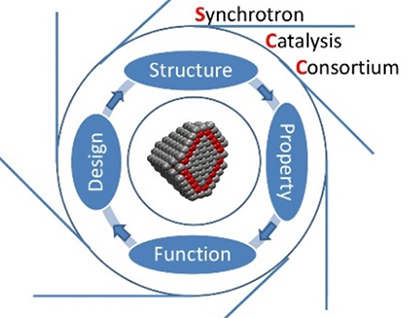Improving Catalysis Science with Synchrotrons
The Synchrotron Catalysis Consortium (SCC) celebrates 10 years of helping scientists.

The Science
Catalysts, the materials that drive the reactions at the heart of refineries, manufacturing plants, and many other industrial processes, are critical to the global economy and have been the subject of research for decades. Despite their unique advantages, x-ray synchrotron spectroscopy techniques were not widely employed by those delving into the intricacies of catalysts. The Synchrotron Catalysis Consortium (SCC) was established to address this situation by providing scientists a means to study catalysts at work under realistic conditions and developing new techniques to characterize catalysts.
The Impact
Since its creation in 2005, the SCC has assisted more than 2,000 users in using synchrotron resources for catalysis research. SCC strengthens U.S. catalysis science by providing timely and efficient access to state-of-the-art synchrotron methods for in situ catalyst studies. Since its establishment more than 10 years ago, SCC has assisted scientists from 75 research groups, leading to more than 400 publications. SCC has offered training courses in carrying out the experiments as well as the required complex data analysis to 371 catalysis researchers, with more than 70 percent being graduate students and postdoctoral fellows.
Summary
X-ray synchrotron spectroscopy offers unique advantages over conventional materials characterization techniques, including higher detection sensitivity and molecular specificity, faster detection rate, and more in depth information regarding the structural, electronic, and catalytic properties under in situ reaction conditions. Despite these advantages, synchrotron techniques were often underutilized or unexplored by the catalysis community due to various perceived and real barriers. The SCC team, consisting of synchrotron experts from academic, national, and industrial laboratories, has implemented a suite of beamlines for catalysis studies at the National Synchrotron Light Source (NSLS), Stanford Synchrotron Radiation Lightsource (SSRL), and NSLS-II synchrotron user facilities. These coordinated efforts have led to a much more efficient utilization of these U.S. Department of Energy synchrotron facilities, which should ultimately benefit the nation as a whole by increasing the return on the investments made in our national laboratory system.
Contact
Anatoly Frenkel
Yeshiva University
afrenke2@yu.edu
Jose Rodriguez
Brookhaven National Laboratory
rodrigez@bnl.gov
Jingguang Chen
Columbia University/Brookhaven National Laboratory
jgchen@bnl.gov
Funding
Funding is provided by the U.S. Department of Energy, Office of Science, Office of Basic Energy Sciences, Division of Chemical Sciences, Geosciences and Biosciences.
Publications
A.I. Frenkel, J.A. Rodriguez, and J.G. Chen, “Synchrotron techniques for in situ catalytic studies: Capabilities, challenges and opportunities.” ACS Catalysis 2, 2269 (2012). [DOI: 10.1021/cs3004006]
Related Links
The Synchrotron Catalysis Consortium (SCC) Homepage
Highlight Categories
Performer: University , DOE Laboratory , SC User Facilities , BES User Facilities , NSLS , SSRL



